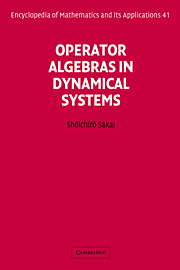Preface
Published online by Cambridge University Press: 27 March 2010
Summary
Derivations appeared for the first time at a fairly early stage in the young field of C*-algebras, and their study continues to be one of the central branches in the field. During the past four decades, the study of derivations has made great strides. Their theory divides naturally into two major parts: bounded derivations and unbounded derivations. About thirty years ago, Kaplansky (in an excellent survey [97] on derivations) brought together two apparently unrelated results which stimulated research on continuous derivations. The first, related to quantum mechanics and due to Wielandt [190] in 1949, proved that the commutation relation ab − ba = 1 carinot be realized by bounded operators. The second, involving differentiation and due to Šilov [180] in 1947, proved that if a Banach algebra A of continuous functions on the unit interval contains all infinitely differentiable functions, then A contains all n-times differentiable functions for some n.
It is noteworthy that Kaplansky's observations three decades ago are still applicable to recent developments in the theory of unbounded derivations, although one has to replace quantum mechanics by all of quantum physics. Furthermore, the work of Šilov continues to have a strong influence on the study of unbounded derivations in commutative C*-algebras.
At an early stage, mathematicians devoted most of their efforts to the study of bounded derivations, rather than unbounded ones, even though the work of Šilov and Wielandt had already suggested the importance of unbounded derivations. This, of course, is understandable because bounded derivations are more easily handled than unbounded ones.
- Type
- Chapter
- Information
- Operator Algebras in Dynamical Systems , pp. ix - xiiPublisher: Cambridge University PressPrint publication year: 1991

